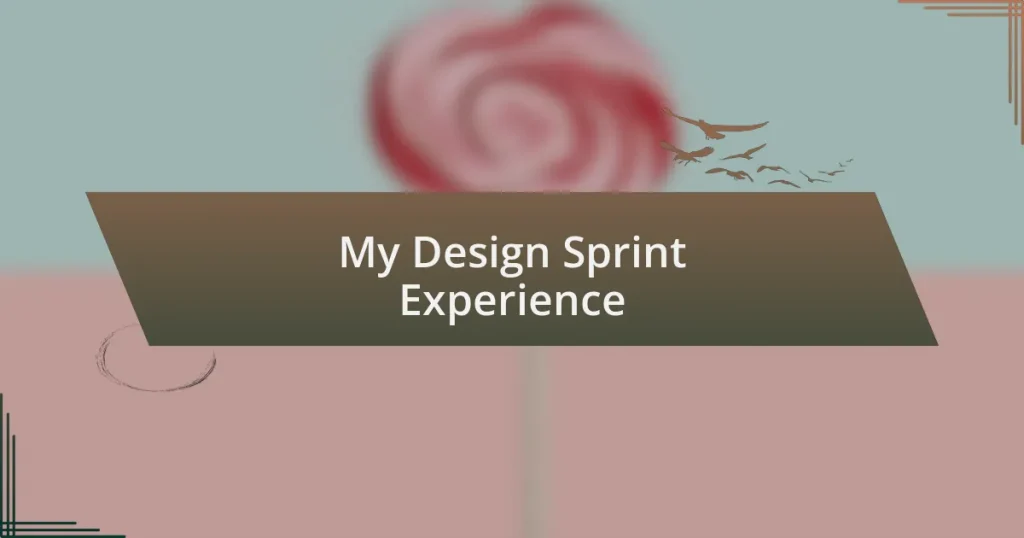Key takeaways:
- Design sprints condense months of development into a focused week, fostering rapid innovation and creativity.
- Preparation is critical: a diverse team, thorough research, and a conducive workspace enhance outcomes.
- Key outcomes include prototype development, user feedback, and team alignment, which reinforce the effectiveness of collaborative design.
- Lessons learned highlight the importance of time management, embracing failure, and including diverse perspectives for enhanced creativity.
Introduction to Design Sprints
Design sprints are a game-changing approach I’ve seen in action, effectively condensing months of development into a single, focused week. This rapid design methodology enables teams to tackle complex problems and validate ideas in just five days, making it an exhilarating journey of creativity and collaboration. Have you ever wished you could fast-track decision-making and innovation? Design sprints might just be the solution.
During my first design sprint, I was admittedly skeptical – could we really accomplish anything meaningful in such a short time? To my surprise, the intensity of the process brought out ideas that had been sitting dormant for ages. It’s as if the sprint unlocked a hidden reservoir of creativity within the team, pushing us to think outside the box. I still remember the surge of adrenaline as we collaboratively sketched solutions and tested prototypes, making the days feel both exhausting and exhilarating.
At the core of a design sprint is the commitment to learn through action—a principle I wholeheartedly embrace. By prioritizing hands-on experimentation and user feedback, this approach fosters a culture of innovation that sparks excitement. So, have you ever considered the power of swift iteration and real-time learning? It’s truly empowering to witness how a week dedicated to creativity can steer a project into uncharted, yet promising, territories.
My Preparation for the Sprint
When I first started preparing for a design sprint, I knew the importance of gathering the right team. Selecting individuals with diverse skill sets and perspectives was crucial. I vividly remember the energy shift in our first meeting; it felt like the right combination of personalities and expertise could propel us toward innovation. The excitement was palpable, and I couldn’t help but think, “This is going to be something special.”
Additionally, I dedicated time to thoroughly research the problem we aimed to solve. I realized that without a strong foundational understanding, we’d be fumbling in the dark. It was enlightening to dive deep into user interviews and existing data. This process not only sharpened my focus but also ignited a passion for the challenge ahead. Having that solid groundwork gave me a sense of confidence. It turned the sprint into a journey of discovery rather than just an exercise in brainstorming.
One critical aspect of my preparation was creating a conducive environment. I remember arranging our workspace to inspire creativity and collaboration, using whiteboards and sticky notes to allow ideas to flow freely. It was amazing how changing the physical space heightened our enthusiasm. I learned that the environment could either stifle or spark creativity, and I wanted ours to be a launchpad for innovation.
| Preparation Element | Description |
|---|---|
| Team Selection | Diverse skill sets and perspectives to enhance creativity. |
| Research | Deep understanding of the problem to provide a strong foundation. |
| Workspace Arrangement | A creative environment that fosters collaboration and idea generation. |
Outcomes and Results Achieved
Outcomes and Results Achieved
The outcomes of our design sprint were nothing short of transformative. I was genuinely amazed by how much clarity and direction we gained in such a short time. It felt like our initial ideas, raw and unrefined, evolved into actionable solutions that had the potential to make a real impact.
From my experience, the most significant results included:
– Prototype Development: We created a tangible prototype that allowed us to visualize our concepts.
– User Feedback: Engaging users for their input was enlightening and led us to refine our ideas further.
– Team Alignment: Everyone left the sprint on the same page, united by shared goals that drove our enthusiasm for the next steps.
Reflecting on our achievements, I distinctly remember the moment we shared our prototype with potential users. Their insights sparked joyful discussions and a few “Ah-ha!” moments that shifted our perspective. It was incredibly rewarding to see how our collective efforts coalesced into something meaningful, reinforcing my belief in the power of collaborative design. Each accomplishment reinforced not just our goals but also the importance of teamwork and input from the very people we aimed to serve.
Lessons Learned for Future Sprints
One of the key lessons I learned during our design sprints is the importance of time management. I remember our first sprint, where we underestimated the time needed for each stage, especially ideation. It was a scramble to fit everything in, which ultimately affected the quality of our outcomes. If I had to do it over again, I’d prioritize a more structured timeline, allowing ample time for brainstorming and reflection.
Another important takeaway was embracing failure as part of the process. In one sprint, we developed a prototype that we were excited about, but user testing revealed it missed the mark. Instead of feeling defeated, I learned to see that setback as an invaluable opportunity to pivot. How often do we allow ourselves to fail forward instead of getting stuck? Adopting this mindset not only helped our team innovate but also fostered a culture where everyone felt safe to share bold ideas.
Finally, including diverse perspectives from the outset is crucial. I still recall the time we brought in a member from a completely different department. They questioned assumptions that the rest of us had taken for granted, leading to breakthroughs I never anticipated. The diversity of thought and experience truly enhanced our creative process. So, how can we ensure we’re inviting this diversity into future sprints? I believe it’s about being intentional in our team composition and encouraging open dialogue at every step.
